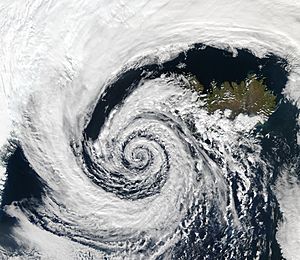Low pressure area facts for kids
A low pressure area, often just called a low, is a place where the air pressure is lower than the air around it. This term is used in meteorology, which is the scientific study of weather.
Because of something called the Coriolis effect, winds around a low pressure area spin. In the northern hemisphere, these winds spin counter-clockwise. In the southern hemisphere, they spin clockwise. This spinning air often creates different kinds of storms. These can include tropical cyclones, extratropical cyclones, and other types of cyclones. Sometimes, people also call them "low-pressure cells."
Contents
How Do Lows Form?
Low pressure areas usually form when warm, moist air rises. As this warm air goes up, it leaves less air pressing down on the surface. This creates an area of lower pressure. When air rises, it cools and the water vapor in it turns into clouds. This is why low pressure areas are often linked to cloudy and rainy weather.
What Weather Do Lows Bring?
Low pressure systems are often connected to bad weather. They typically bring clouds, rain, and sometimes strong winds. If the low pressure is very strong, it can lead to severe storms. These storms can include thunderstorms, blizzards, or even hurricanes and typhoons. The rising air and moisture create the perfect conditions for these weather events.
Types of Low Pressure Systems
There are several types of low pressure systems, each with unique features. They form in different parts of the world and cause various kinds of weather.
Tropical Cyclones
Tropical cyclones are powerful low pressure systems that form over warm ocean waters. They are known by different names depending on where they form. In the Atlantic and Northeast Pacific, they are called hurricanes. In the Northwest Pacific, they are called typhoons. In the Indian Ocean and South Pacific, they are simply called cyclones. These storms have a calm "eye" in the center and bring very strong winds and heavy rain.
Extratropical Cyclones
Extratropical cyclones form outside of the tropics, usually in the middle and high latitudes. They are also known as mid-latitude cyclones. These systems are responsible for much of the day-to-day weather changes in many parts of the world. They often bring fronts, which are boundaries between different air masses. These fronts can cause rain, snow, and changes in temperature.
Subtropical and Subpolar Cyclones
There are also subtropical cyclones, which have features of both tropical and extratropical cyclones. They form in areas between the tropics and the mid-latitudes. Subpolar cyclones form in very cold, high-latitude regions. They are less common but can still bring significant weather.
Images for kids
-
A clockwise spinning low-pressure area or cyclone of southern Australia. The center of the spiral-shaped cloud system is also the center of the low.
-
This picture shows the Hadley cell, which helps create low-pressure areas. Air rises, causing lower pressure at the ground and leading to upward motion.
-
QuikSCAT image of typical extratropical cyclones over the ocean. Notice the strongest winds on the poleward side of the occluded front.
See also
 In Spanish: Borrasca para niños
In Spanish: Borrasca para niños







